1976 Italian Grand Prix race report
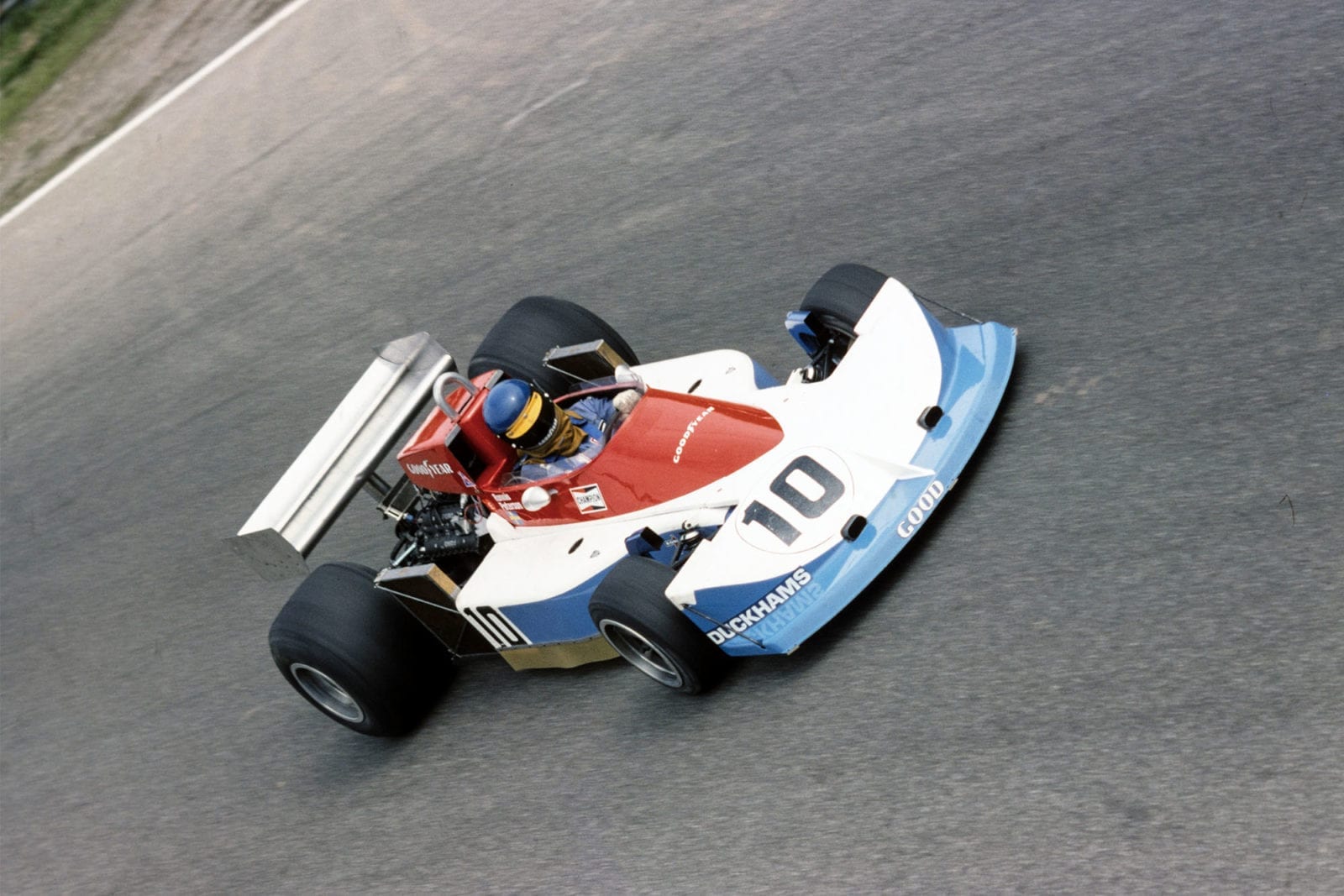
Ronnie Peterson took his first win for two years at Monza
Motorsport Images
Lauda’s comeback
Monza, Italy, September 12th
It is never very clear who instigates the changes to circuits, but the reasons are usually “in the interests of safety” though more attention could be paid to racing car design and manufacture, to say nothing of closer inspection of components. Teaching some drivers to drive more carefully could also add its quota to making motor racing safer. This year the Monza Autodromo has undergone some major changes in the interests of “safety” and the best thing that has happened is the total elimination of the stupid artificial chicane just beyond the end of the pits. Much further on, at the very beginning of the Curva Grande a new complex of two ess-bends joined by a short straight has been built. At the end of the main straight, instead of setting the car up for the challenging high-speed right-hand curve, you now brake really hard for a sharp left/right ess-bend, This is followed by a quick “squirt” to another left/right ess-bend and then you accelerate round what is left of the Curva Grande. This double-ess has been properly constructed with bevelled kerbs and grass verges and has been blended into the circuit remarkably well. If you overdo it on initial braking you can run straight on into a great sea of fine gravel in which even a Formula One car would sink to some depth. To retrieve cars from this over-shoot area there is a permanent mechanical winch and hawser to one side with a grappling hook always at the ready. On the outside of this new double-ess five grandstands have been built, giving spectators a fine view of the track. From the Curva Grande the cars get back up to a fair turn of speed on the run down to the Lesmo corners. To stop anyone going into these corners too fast another permanent left/right ess-bend has been built just before the original braking area. On leaving this ess-bend there is barely time to accelerate before arriving at the first of the Lesmo corners. These two modifications to Monza have removed all the challenge from the Curva Grande and the Lesmo and reduced them to the lowest common driving denominator, just as the chicane has decimated the once challenging Woodcote Corner at Silverstone. On the back leg of Monza the permanent ess-bend at Viatone corner remains unchanged, as does the Curva Sud or Parabolica. Whether all these alterations make Monza better, worse or safer, is a matter of opinion, but they certainly make it different and in the face of a lot of opposition to motor racing it is better to have a “different” Monza than no Monza at all. Whatever else may be thought of the modifications their construction would appear to be faultless, the rear road surface being excellent and its blending into the old surface is a lesson to all circuit builders.
Qualifying
The effect of all this stopping and starting is to add some ten seconds to the lap time and reduce the average speed from around 138 m.p.h. to well under 130 m.p.h.; still a respectable average speed but a shadow of former days when Monza was lapped at over 150 m.p.h. However, the best intentions can misfire and the weather man must have thought to himself, “if they want to slow the pace at Monza, I’ll show them how to do it” and on Friday morning when practice was due to start the rain was pouring down. Only three drivers braved the floods, these being Brambilla, Perkins and Stommelen, the orange March splashing round for quite a number of laps and recording the fastest at just under 80 m.p.h.! The Australian in the Dutch-owned Ensign demonstrated aquaplaning to the assembled company huddled in the pits, by spinning on the straight and the German driver tried to settle himself into his new position in the Ecclestone Alfa-Romeo team where he was replacing Reutemann. The swarthy Argentinian had terminated his contract with Ecclestone immediately after the Dutch GP and had joined the Ferrari team alongside Lauda, who was making a brave return to racing sooner than anyone expected, and Regazzoni.
Although the torrential rain eased off towards mid-day it did not really stop, and the clouds were almost down on the ground, but as conditions were obviously not going to improve everyone decided to get on with it. Brake air scoops and ducts were taped over, ignition systems and sparking plugs were waterproofed, cockpit air vents were covered up, rain tyres fitted all round and everyone knew exactly what they were in for. Reutemann set the ball rolling and when Lauda appeared everyone cheered and clapped to welcome him back. Apart from obvious signs of burns around the ears he was looking pretty fit, and though he did not indulge in any heroics in the wet conditions he was greeted with enthusiasm all round the circuit. In contrast Hunt was greeted with whistles and cat-calls every time he appeared anywhere and especially as he set off on his opening lap. He did not complete the lap, spinning off on the last corner and damaging the nose cowling. It was not serious, but he took the spare McLaren while the damage was put right. After some cautionary laps of investigation some of the drivers really got stuck into the job of rain driving, notably Stuck, lckx, Fittipaldi, Edwards, Andretti, Peterson and Laffite and at times you would have thought the track was dry by the way Stuck was flinging the white March through the new double-ess. He was even seen to overtake slower cars between the two ess-bends! As far as achieving anything the whole day was an absolute dead-loss, but there was no sign that the weather was going to improve so some sort of performance had to be registered and Stuck and Peterson were on their own with laps at just over two minutes. Not surprisingly Jacky lckx was third fastest with the dark blue Ensign, though his driving had not looked at all spectacular; he had achieved his speed by finesse rather than bravado. Shortly before it was all over both Stuck and Regazzoni had excursions off the track, but neither was serious.
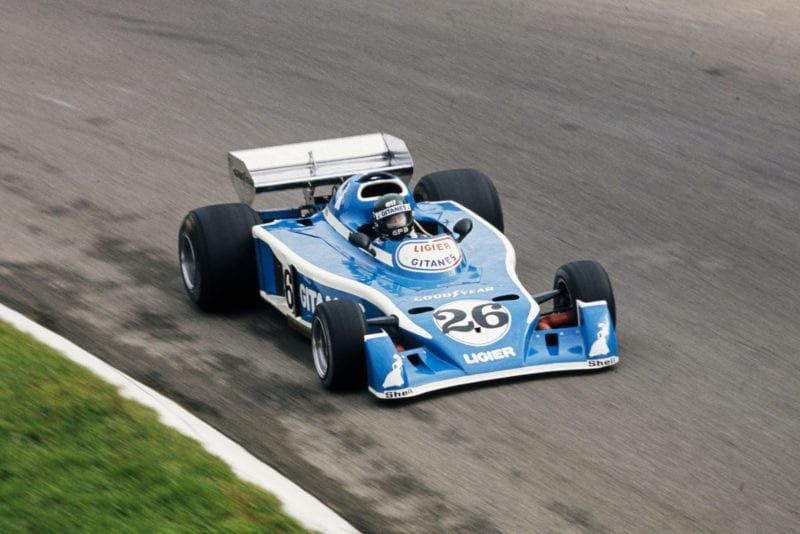
Jacques Laffite put his Ligier on pole
Motorsport Images
On Saturday morning the scene was still pretty grey, but at least it was fine and dry. With the new arrangement of practice, tried in Holland, of settling the grid positions in the morning and having the afternoon free for testing, everyone had to get off the mark very promptly. It really was a very good practice session for not only were they all driving hard to get in a good lap time, but there was a lot of “racing practice” going on with drivers out-braking each other into corners, going past slower cars in some desperate manoeuvres, scratching round the corners on the limit of adhesion and enjoying the whole business. This new-look attitude of “racing is fun” became first apparent in Austria and seems to have caught on, even among some of the top money-earners who cannot afford to take any chances. Stuck, Peterson, Pace, Scheckter, Depailler, Laffite, and Regazzoni were all obviously out to win. Lauda was quietly demonstrating that he had lost none of his touch, Ickx was up there with them all, but Hunt just could not seem to get in the game, nor could Brambilla. One driver who was embarrassing a lot of people was the be-spectacled Australian Larry Perkins, running his whole show himself, and recording a time that must have given him a “double-A for effort” in anyone’s book, for he split the two works Lotus drivers on the final grid. Admittedly Andretti was in trouble with the final-drive unit on 77/R3 going wrong and he had to use his spare car, but even so the Lotus team were not really in the picture. Another car to have trouble was the new McLaren M26, which seized the left-rear hub bearings so badly that the steel hub turned blue with the heat! This put a stop to the progress of Mass, and he had to use the spare car.
In view of the disastrous previous day the one hour on Saturday morning was all too short, but the result produced a most interesting starting grid. Laffite had got the Ligier-Matra V12 on pole position, with Scheckter alongside him, and behind them were Carlos Pace and Depailler. Standing out in row three was Niki Lauda, fastest of the three Ferraris, with Stuck alongside him. So in the first six we had a French V12 engine, two Italian flat-12 engines, two six-wheeled cars and one conventional “British Kit-Car.” With the Matra V12 and an Alfa Romeo flat-12 engine ahead of the first Ferrari, the telephone line to Modena was getting pretty hot! For no very obvious reason Hunt was down in ninth place, but during the morning scratch it was noticeable that he did not mix it in with the others. At one point he got embroiled with a bunch of “chargers” but immediately pulled into the pits. Since the Brands Hatch farce (called the British GP) the Italian papers have been antagonising Hunt and the McLaren team, suggesting they are “protected” by the British Formula One Mafia and also making allegations about McLaren engines running on illegal petrol. All this and the continual whistling and booing would be enough to unbalance the most lethargic mind. Another driver who could not seem to get into the groove was Brambilla, there being nothing wrong with the orange March, nor were there any team problems, but he ended the practice hack amongst the Shadow cars.
The 1 1/2-hour test-session in the afternoon took on a significant note for few of the teams had reached their peak during the morning and adjustments and juggling with the variables continued after lunch. A lot of drivers improved on their morning times, but only by private hand-timing, for the official clocks were switched off. During this period Mass was out in the repaired McLaren M26, Scheckter tried the latest P34 Tyrrell with the new rear aerofoil, Peterson tried the spare March and decided he preferred it to the one he had set his grid time with, Mass decided to race the spare McLaren instead of the M26 and both works Surtees drivers spun off at the Lesmo chicane. Everything eventually wound down and the mechanics set to and changed engines, checked gearboxes, fitted new clutches and generally tore all the cars apart to prepare them ready for the brief test-session on Sunday morning and the race in the afternoon. The technical committee of the Automobile Club of Italy took samples of the petrol being used by number of competitors and the cars were scrutinized pretty closely on vital measurements.
Race
At mid-day on Sunday the race officials announced that the octane number of the petrol used by a random selection of teams had been checked and both McLaren and Penske had been found to be over the prescribed limit. In consequence their times recorded on Saturday were declared null and void and their positions on the starting grid would be according to times recorded on Friday. This was decided because the fuel samples were taken on Saturday and it could not be proved or disproved that they were using non-standard fuel on Friday, so they were given the benefit of the doubt. As things had stood, with only 26 starters being allowed, Lunger and Merzario had been posted as first and second reserves, but their new bombshell meant that they were now accepted in the race, Hunt was in last position, Mass was first reserve and Watson was second reserve. However, it did not end there, for Frank Williams had packed up and gone home on Saturday night so Merzario had no car. Hunt was now moved across to the penultimate grid position and Mass, as first reserve moved into the last position on the grid, leaving Watson as the only reserve.
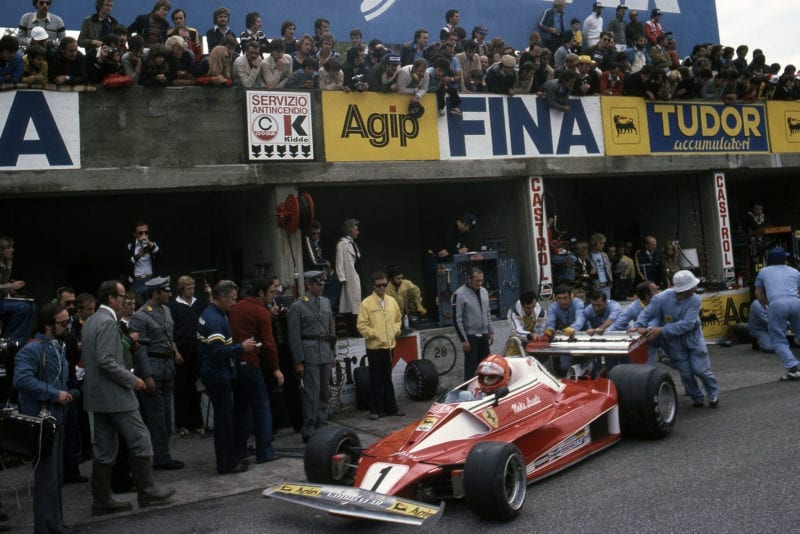
Niki Lauda prepares to leave the pits
Motorsport Images
Needless to say Teddy Meyer and the Texaco fuel people were three feet off the ground with indignation and were filling in protest forms on behalf of McLaren Racing as fast as they could go, while Roger Penske had a look of sheer disbelief on his face. This master-card by the Italians to fix any potential challengers to Lauda and the Ferraris was more impressive than anything seen in USAC or NASCAR racing in America. Much more troubled were Penske’s sponsors, the First National City Bank Travellers Cheques corporation who had a grandstand full of VIP’s to see Watson repeat his Austrian victory. As luck would have it the spare March, which Peterson was going to use still had the Citibank advertising under the sticky tape, so Max Mosley was suitably rewarded to get his mechanics to carefully peel off the masking tape. Meanwhile, Guy Edwards, who knows which side of the bed the Travellers Cheques are kept, sportingly withdrew his Penthouse/Rizzla sponsored Hesketh so that John Watson could take his place.
While all this political business uproar was going on the cars were being prepared for the 3.30 p.m. start and a lot of people completely forgot about lunch in the general uproar. One or two teams, who appear to be blameless in all the squabbles this season, were looking sideways, at the McLaren team and thinking that perhaps it doesn’t pay to invoke the wrath of Enzo Ferrari, while others were tracing the root-cause back to Brands Hatch 1974 when the RAC really fell foul of Ferrari over the pit-lane nonsense on the last lap of the British GP. Some people even went so far as to suggest that Ferrari had the Pope on his side! Whatever the reasons, the outcome was that the 26 cars lined up on the grid with the two McLarens on the back row. The Marlboro cigarette firm had laid on some start-line publicity with a troupe of dolly-birds, which all went a bit flat with the publicity at the front of the grid and the team cars at the back of the grid. As the cars had set off from the pits to drive round to the start line Lauda had received a terrific ovation, Regazzoni had been equally popular, while the mass of spectators did not seem to understand Reutemann in the third Ferrari. The more wealthy spectators who had seats in the Main grandstand cheered and waved Hunt as he set off, but the hoy-poloy around the circuit booed and whistled, and there were some 80,000 of them. The new system of starting procedure was employed, whereby everyone lined up on the starting-grid and then set off on a warm-up lap in formation, led by the poleposition car. The weather was cord and grey as Laffite took them round the track, but it was dry and everyone drew up in position to start the 52 lap race. With the last minute substitution of Watson for Edwards a gap was left in the penultimate row where the Hesketh should have been and Watson was positioned all alone at the back behind Hunt.
The starting signal was given by red and green lights in a most undramatic manner and the lack of a 10 second count-down board caught out some of the drivers, including Lauda. The Ligier and the Tyrrell on the front row roared away, with Scheckter taking the lead from the Ligier. Jochen Mass passed a handful of cars even before he reached the timing line, Watson shot past Hunt and then they were all gone down to the first chicane. Scheckter led Laffite, Depailler, Peterson, Reutemann, Regazzoni, Pace and Stuck at the end of the opening lap so there had obviously been a fair bit of chopping and changing going on round the back of the circuit. Mass was up in mid-field already and picking off cars in quick succession while Watson was still ahead of Hunt. Next time round there was no change among the leading group but Reutemann had lost contact with the first four and Regazzoni was closing on him. Pace was dropping back but Lauda was moving up, and Mass drew into the pits with trouble in the ignition distributor and that was the end of his sprint from the back. On lap 3 Peterson shot through from fourth place to second place, but the first four were still in very close contact. On the next lap Depailler passed Laffite for third place and Regazzoni took fifth place from Reutemann. Lauda was now in fourth place, Watson fourteenth and Hunt fifteenth. Nilsson drew into the pits with the nose cone rubbing on the ground and a new one was fitted, but the stop dropped him right to the back of the field. Pace had stopped out on the circuit on lap 3.
By six laps a pattern was forming, Scheckter led from Peterson, Depailler, Laffite and Regazzoni, a bare four seconds covering the five cars, then came Reutemann, Stuck, Brambilla and Lauda, the reigning World Champion having passed Andretti and having his sights on the orange March ahead of him. The Lotus team leader was all on his own and then came a tight bunch comprising Ickx, Pryce, Watson and Hunt. Leading the rest was Alan Jones, closely followed by Perkins with Pescarolo right at the back, apart from Nilsson who had made a pit stop. At eight laps the two six-wheeled Tyrrells and the red, white and blue March had begun to pull out a gap from the Ligier-Matra and Regazzoni was looking ready to do some overtaking. Stuck had had a “moment” and dropped back behind Brambilla and Lauda, and Hunt got past Watson. By the end of lap 9 Peterson was closing visibly on Scheckter and poor Perkins went out in a spectacular cloud of smoke as his Cosworth engine blew up opposite the pits, a disaster he could ill-afford. On the tenth lap Peterson was taking aim at the leading six-wheeler, while Regazzoni was doing likewise with the Ligier-Matra. Hunt passed Tom Pryce but was not closing on lckx, and was in twelfth position. As anticipated Peterson took the lead on lap 11 and Regazzoni moved up into fourth place ahead of Laffite. Reutemann had dropped back behind Brambilla and Lauda and the scene seemed to he settling down, but not for long. On lap 12 Hunt made a bit of a nonsense in the first chicane and Pryce was alongside the McLaren as they rounded the Curva Grande. Wheel to wheel they raced down to the Lesmo chicane, with Pryce knowing the new Shadow brakes were very good. He sat it out into the braking area, scrabbled round the ess-bend and left a disillusioned James Hunt climbing from his McLaren well off the road and out of the race! Not only the Italians were giving the blonde Englishman a rough time, now the Welsh were being beastly.
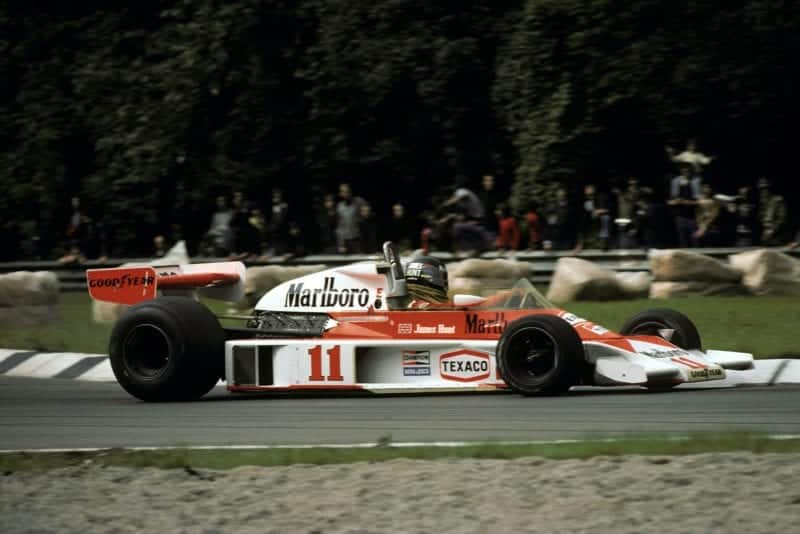
James Hunt (McLaren) spun off on Lap 11
Motorsport Images
At the end of lap 13 Lauda passed the grandstands to wild cheering as he was alongside Brambilla and about to take sixth place, which he did as they headed for the first chicane while Depailler passed Scheckter, whose engine was losing its fine edge and then everything settled down for a hit. The average speed had started off at 194 k.p.h. and had climbed to 200 k.p.h. (124 m.p.h.) by lap 17. Pescarolo stopped to change a tyre on lap 20 and Andretti was attacking Stuck for ninth place. This Lotus/March battle went on for a number of laps and at 22 laps a dejected Hunt came walking back down the track to cheers from his supporters and whistles from his opponents. On lap 23 a fine rain began to fall, not enough to wet the track but sufficient to make spectators raise umbrellas. Scheckter was passed by Regazzoni and then by Laffite, but all the while Peterson was out in front with Depailler hanging on and not losing any ground. The Andretti/Stuck battle came to a sudden end at the first chicane when they bad a misunderstanding and both spun off the course after a slight collision. Andretti was prepared to restart the Lotus, but the compressed air starter failed to work. The March had dented the left side of the Lotus and under the cowling the air bottle is located. By sheer chance the March wheel had broken the valve off the top of the bottle and let all the air escape, so Andretti was unable to restart.
Now a very strange thing happened, the Clerk of the Course appeared on the finishing line with a black flag accompanied by a black board with a white cross on it. Very few people seemed to know what it meant, but anyone who had read the supplementary regulations carefully knew that it indicated that next time round the flag would be shown and the race would be stopped. There was an instant fluttering of various officials and men from the various Unions as well as the tyre men, and next time that Peterson went by there was no red flag; not that he had looked like slowing down. Nor for that matter had Depailler in second place; but Regazzoni in third place had eased off, but seeing the two cars ahead disappearing he soon opened up again. Laffite in fourth place eased back and was promptly passed by Scheckter, and red flag or no red flag, they were all racing again. The fine rain which had prompted this action did not develop, but among the tail-enders Jones, Fittipaldi and Lunger all drew into the pits thinking the race was being stopped. They soon shot back into the fray while team managers yelled and shouted and there was a rare old shemozzle at race control. Out on the track everything settled down again, except that Laffite could not recover his fourth place from Scheckter. At the front Depailler was trying all he knew to harass Peterson and for a brief moment on lap 31 actually got his six-wheels ahead of the March, but not long enough to lead across the line. Laffite was making up ground on Scheckter and Lauda was gaining on them little by little. Down among the also-rans Stommelen had to stop when his Alfa Romeo engine went sick, but after two pit stops he struggled on, and Lauda was actually racing Fittipaldi for sixteenth place.
By 40 laps Laffite had regained his rightful fourth place and now Lauda had the six-wheeler in view. With the slight dampness the race average had dropped to 198.9 k.p.h. and there was a stalemate between Peterson and Depailler and it began to look as if the March might keep going. Laffite was now pressing Regazzoni and the two of them were closing on Depailler. On lap 46 the foremost Tyrrell had its engine go flat and instantly the following Ferrari and Ligier were by. Lauda had passed Scheckter on lap 41, so it was not a good day for the six-wheelers. With the end in sight Peterson was keeping his fingers crossed that the March would not let him down, and his lead was a very bare three seconds. As they lapped some of the slower cars in the closing laps Regazzoni reduced the gap to under two seconds, but it was only temporary and Peterson and the March held together to win the Italian GP by less than two and a half seconds at an average speed of 199.749 k.p.h. Regazzoni and Laffite were second and third, both feeling that they might have been able to win if the muddle of the black flag had not occurred. Poor Depailler popped and banged round for the last two laps, Lauda and Scheckter both overtaking him, and from a secure second place he had to be content with sixth place.
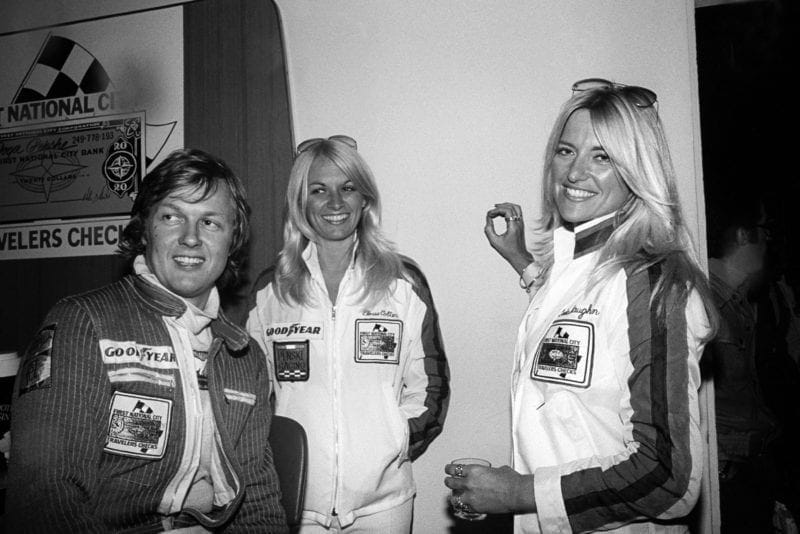
Peterson is congratulated on his win
Motorsport Images
In fourth place Lauda received a terrific ovation for he had shown in no uncertain manner that he was well and truly back in the game. He twice made fastest lap towards the end of the race, but Peterson set a new record on lap 50. On the last lap Lauda faulted coming out of the ViaIone chicane, and Scheckter closed up on him but the World Champion stayed in front again at the Parabolica corner and led the South African over the line by a mere tenth of a second. As the cars did their slowing-down lap the crowds swarmed onto the track from all directions and Peterson was a very popular winner, this being his third Monza victory. March were unbelievably happy for it was the first real victory for the works team (last year’s Austrian GP being only half a race). Regazzoni’s appearance on the winner’s rostrum was greeted by cheering that must have been heard in Milan, and then a rhythmic chant began for Lauda. The whole starting area was a milling throng of thousands upon thousands, no-one denying that Lauda was the real hero of the day. Although he had finished a magnificent fourth he was completely exhausted and quite unable to get to the winner’s rostrum but he must have been very moved to hear everyone calling for him. It had been a momentous Italian GP in more ways than one and as the cheering and chanting died down, Hunt’s supporters could be heard complaining that the whole affair was irregular and McLaren and Texaco were protesting the whole validity of the race. Another typical 1976 finish to a race. The year of the rule book goes from strength to strength.—D.S.J.
Monza Mutterings
It was said that Scheckter was trying to impress on Ken Tyrrell that he had made a bad mistake dropping him in favour of Peterson for 1977. Second fastest in practice and race leader until the engine lost its edge was pretty convincing. However, Peterson won the race, and in a March.
* * *
Ferrari started three cars and finished three cars. Tyrrell started two and finished two, all in the first ten. Surtees started three cars and they all finished, but in the second ten.
* * *
It was a truly International result, the finishing order was Sweden, Switzerland, France, Austria, South Africa, France, Italy, Wales, Argentina, Belgium, Ulster, Australia, Sweden, America, Brazil, Austria, France, Italy and France. Wot! No English!
